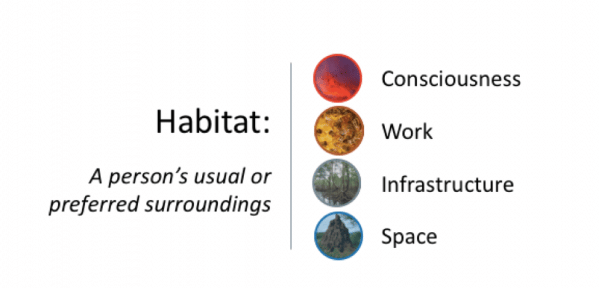My nephew is a big fan of nature. He regularly pulls out odd facts about animals I’ve never heard of. Admittedly, I’m a much better-informed auntie. Its probably because of these conversations that I’ve been paying more attention to articles about biomimicry, (taking design hints from nature to solve problems humans have). And thinking about how learning occurs in nature.
Learning organisms and habitat
In March, I wrote about learning organisms. To summarize, in more evolved organizations, learning has pretty much taken on a life of its own. These organizations have in essence become organisms that learn, grow, and develop based on their habitat and their ability to make use of it. The more cohesive the habitat is, the more quickly learning organisms are able to react to environmental change, take calculated risks, and evolve as necessary.
More recently, as I’ve planned for a couple of Degreed Focus events, learning habitat has continued to surface as an important point. More evolved organizations react to the external environment by carefully crafting the internal habitat. Most of the things they do to create habitat fall within four major areas:
- Consciousness. Learning organisms carefully craft messages and actions around the importance of employee development. They clearly define what it means to be developed in the organization, and they have a collective consciousness about how it will be done. Shared consciousness in an organization sets the tone for how important employee development will be taken. Leena Nair, CHRO of Unilever, makes this point with a recent tweet & LinkedIn discussion.
- Use of work. As it turns out, no other animal in the animal kingdom, besides humans, gets classroom lessons on how to do their job. Learning most often happens in the flow of work, as recent research from Bersin and Bersin ideas from thinkers like Harold Jarche tell us. Learning organisms default first to the work for development.
- Infrastructures. Infrastructures, including systems and processes, are the pathways by which learning organisms share information and do work. They are crucial because they can either encourage or greatly discourage progress and performance. Learning organisms are conscious of how their infrastructures, either encourage or discourage progress and performance and continuously make necessary adjustments.
- Space. Physical and virtual space also affect how individuals learn. (I owe a conversation I had with Frank Graziano at Steelcase for sparking thinking on this topic; Read here for more.) While most L&D professionals understand the importance of the setup of a classroom, the idea of space in habitat goes beyond that. Learning organisms focus on ensuring the alignment and cohesiveness of physical and virtual spaces with work goals and employee development goals.
What habitats mean for L&D
The sole responsibility of L&D function is to ensure a skilled workforce. Hard stop. Habitat plays a large role in that. And focusing on habitat changes the job of the L&D function to a great extent. Aside from the obvious things, like a lesser focus on facilitation and content creation, establishing a deliberate learning habitat also requires several skills and capabilities that are likely unfamiliar to many L&D professionals.
Last week in Denver, around 50 L&D professionals joined together to figure out what some of those capabilities should be and how to use the idea of habitat to develop them in their L&D teams. We heard things like “ability to influence”, “marketing and communications”, “analytics and measurement,” and “virtual space design.”
We also talked about adapting more common L&D skills – facilitation, content creation, instructional design to broader tasks that help to create habitat. For example, could instructional design theory be applied to helping organizations design workflows in a way to help employees learn, and can skills that make a good facilitator be adapted to influence and build relationships with key stakeholders?
As we focus on habitats and their importance for the learning organization in the coming months, we’re going to continue to pick the brains of smart people. We want to find out not just what skills they need, but how they’re developing them.
Incidentally, this concept was presented at two Degreed Focus workshops on Learning Habitats and L&D capabilities in Denver and Dallas. You can access the materials used in this Degreed pathway.
This post, titled “Bees, Trees, Termites, Learning Habitats, and L&D Capabilities” was originally featured on the RedThread blog.

